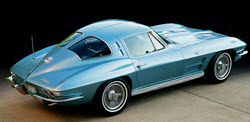1965 Corvette Sting Ray

The 1965 Corvette Sting Ray had a lot of new and much sought after features. It contained a new type of engine, colloquially referred to as the “Big Block”, the 396 cubic inches Turbo Jet. It was a 6.5 L V8 engine rated at 425 hp. No Corvette motor had even been rated above 400 hp before. The 1965 Corvette Sting Ray was nicknamed “Fiberglass porcupine” due to the motor heads. The valves had been placed at odd angles like to the quills on a porcupine.
The 1965 Corvette Sting Ray was considerably heavier than the previous year model, since the new “Big Block” engine weighed 150 pounds more than the old motor. All this extra weight had to be supported by the front wheels and the weight distribution of the Corvette changed dramatically. In the 1965 Corvette Sting Ray, 51% of the weight rested on the front wheels. This was of course a disadvantage when it came to handling the car.
The new “Big Block” engine needed a new hood and Chevrolet designed the attractive bubble hood to accommodate the powerful motor. The new engine also required a better cooling system than the 1964 Corvette Sting Ray.
A much longed for update in the 1965 Corvette Sting Ray was the disc brakes. Disc brakes had been available for an extra fee in the 1964 model, but now it became standard equipment. In most other cars of the 1960s, disc brakes were only used in the front, but if you bought a 1965 Corvette Sting Ray you would get them on all four corners. Inspiration came from Jaguar who had equipped their expensive Jaguar E-Type with this solution. This new feature was especially well received among racers, since the earlier Corvettes were prone to drum brake problems. The 1965 Corvette Sting Ray also had three brake vents behind the front wheels. If you wanted a less expensive 1965 Corvette Sting Ray, you could still go for the drum brakes and have the price reduced by $64.50.
One of the things that makes the 1965 Corvette Sting Ray special is that it was the first time you could get both wheel disc brakes on all four corners and a fuel injected engine in your Corvette. The fuel injected engine was a 327 cubic inches 375hp engine that added $538 to the standard price for a 1965 Corvette Sting Ray. The fuel injected engine was discontinued the next year and did not reappear again until 1982. The few existing 1965 Corvette Sting Rays with the optional fuel injected engine are therefore very special and highly priced among car collectors.
The introduction of side exhaust pipes took place in 1965 and stayed on the Corvettes until the 1970s. The side exhaust pipes had aluminium heat shields, since the driver and passenger might otherwise burn their legs as they left the car after a drive. The bright aluminium heat shields were also good-looking and matched the stunning 1965 Corvette Sting Ray design. The side exhaust pipes had mufflers, but the performance of the mufflers was actually quite low. Since the side exhaust pipes created such a racket, they were labelled “off road” to prevent problems with present and future noise legislation.



